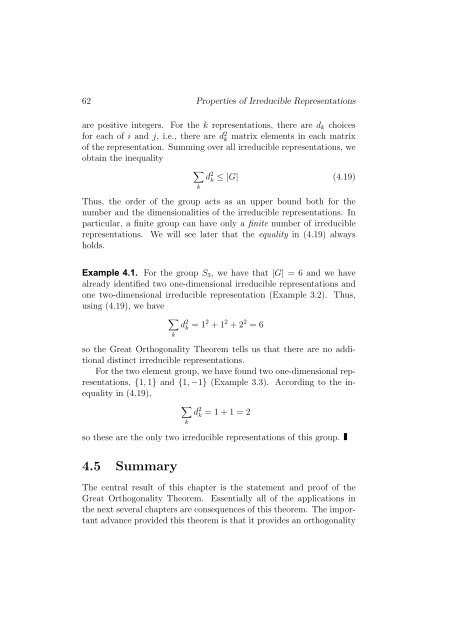Chapter 4 Properties of Irreducible Representations
Chapter 4 Properties of Irreducible Representations
Chapter 4 Properties of Irreducible Representations
Create successful ePaper yourself
Turn your PDF publications into a flip-book with our unique Google optimized e-Paper software.
62 <strong>Properties</strong> <strong>of</strong> <strong>Irreducible</strong> <strong>Representations</strong><br />
are positive integers. For the k representations, there are d k choices<br />
for each <strong>of</strong> i and j, i.e., there are d 2 k matrix elements in each matrix<br />
<strong>of</strong> the representation. Summing over all irreducible representations, we<br />
obtain the inequality<br />
∑<br />
d 2 k ≤|G| (4.19)<br />
k<br />
Thus, the order <strong>of</strong> the group acts as an upper bound both for the<br />
number and the dimensionalities <strong>of</strong> the irreducible representations. In<br />
particular, a finite group can have only a finite number <strong>of</strong> irreducible<br />
representations. We will see later that the equality in (4.19) always<br />
holds.<br />
Example 4.1. For the group S 3 , we have that |G| = 6 and we have<br />
already identified two one-dimensional irreducible representations and<br />
one two-dimensional irreducible representation (Example 3.2). Thus,<br />
using (4.19), we have<br />
∑<br />
d 2 k =1 2 +1 2 +2 2 =6<br />
k<br />
so the Great Orthogonality Theorem tells us that there are no additional<br />
distinct irreducible representations.<br />
For the two element group, we have found two one-dimensional representations,<br />
{1, 1} and {1, −1} (Example 3.3). According to the inequality<br />
in (4.19),<br />
∑<br />
d 2 k =1+1=2<br />
k<br />
so these are the only two irreducible representations <strong>of</strong> this group.<br />
4.5 Summary<br />
The central result <strong>of</strong> this chapter is the statement and pro<strong>of</strong> <strong>of</strong> the<br />
Great Orthogonality Theorem. Essentially all <strong>of</strong> the applications in<br />
the next several chapters are consequences <strong>of</strong> this theorem. The important<br />
advance provided this theorem is that it provides an orthogonality













